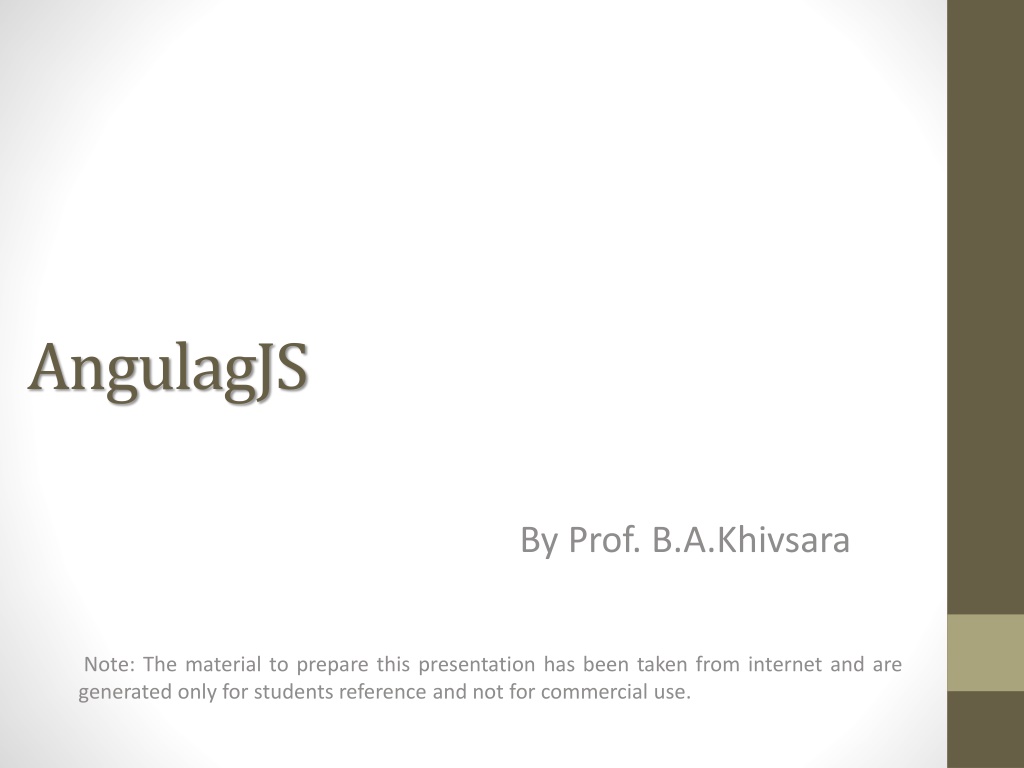Understanding AngularJS Framework for Web Development
AngularJS, a JavaScript framework, enhances web development by extending HTML attributes with directives and binding data with expressions. Learn about its MVC architecture, steps to create AngularJS applications, and explore an example with detailed explanations.
Download Presentation

Please find below an Image/Link to download the presentation.
The content on the website is provided AS IS for your information and personal use only. It may not be sold, licensed, or shared on other websites without obtaining consent from the author. Download presentation by click this link. If you encounter any issues during the download, it is possible that the publisher has removed the file from their server.
E N D
Presentation Transcript
AngulagJS By Prof. B.A.Khivsara Note: The material to prepare this presentation has been taken from internet and are generated only for students reference and not for commercial use.
AngularJS Introduction AngularJS is a JavaScript framework. It can be added to an HTML page with a <script> tag. AngularJS extends HTML attributes with Directives, and binds data to HTML with Expressions. Syntax <script src="https://ajax.googleapis.com/ajax/libs/angularjs/1.6.4/angular.min.js"> </script>
AngularJS - MVC Architecture Model View Controller or MVC as it is popularly called, is a software design pattern for developing web applications. A Model View Controller pattern is made up of the following three parts Model It is the lowest level of the pattern responsible for maintaining data. View It is responsible for displaying all or a portion of the data to the user. Controller It is a software Code that controls the interactions between the Model and View.
Steps to create AngularJS Step 1 Load framework- using <Script> tag. <script src = "https://ajax.googleapis.com/ajax/libs/angularjs/1.3.14/angular.min.js"> </script> Step 2 Define AngularJS Application using ng-app directive <div ng-app = ""> ... </div> Step 3 Define a model name using ng-model directive <p>Enter your Name: <input type = "text" ng-model = "name"></p> Step 4 Bind the value of above model defined using ng-bind directive. <p>Hello <span ng-bind = "name"></span>!</p>
AngularJS Example <html> <script src="https://ajax.googleapis.com/ajax/libs/angularjs/1.6.4/angular.min.js"> </script> <body> <div ng-app=""> <p>Name: <input type="text" ng-model="name"></p> <p ng-bind="name"></p> </div> </body> </html>
AngularJS Example Explained Example explained: AngularJS starts automatically when the web page has loaded. The ng-app directive tells AngularJS that the <div> element is the "owner" of an AngularJS application. The ng-model directive binds the value of the input field to the application variable name. The ng-bind directive binds the innerHTML of the <p> element to the application variable name.
How AngularJS integrates with HTML ng-app directive indicates the start of AngularJS application. ng-model directive then creates a model variable named "name" which can be used with the html page and within the div having ng-app directive. ng-bind then uses the name model to be displayed in the html span tag whenever user input something in the text box. Closing</div> tag indicates the end of AngularJS application.
AngularJS - Expressions Expressions are used to bind application data to html. Expressions are written inside double braces like {{ expression}}. Expressions behaves in same way as ng-bind directives. Using numbers <p>Expense on Books : {{cost * quantity}} Rs</p> Using strings <p>Hello {{fname+ +lname }}</p> Using object <p>Roll No: {{student.rollno}}</p> Using array <p>Marks(Math): {{marks[3]}}</p>
AngularJS Expressions -Example AngularJS expressions are written inside double braces: {{ expression }}. AngularJS will "output" data exactly where the expression is written: AngularJS Example <html> <script src="https://ajax.googleapis.com/ajax/libs/angularjs/1.6.4/angular.min.j s"></script> <body> <div ng-app=""> <p>My first expression: {{ 5 + 5 }}</p> </div> </body> </html>
AngularJS - Controllers AngularJS application mainly relies on controllers to control the flow of data in the application. A controller is defined using ng-controller directive. Each controller accepts $scope as a parameter which refers to the application/module that controller is to control. <div ng-app="myApp" ng-controller="myCtrl">
AngularJS Controllers- Example AngularJS modules define AngularJS applications. AngularJS controllers control AngularJS applications. The ng-app directive defines the application, the ng-controller directive defines the controller. AngularJS Example <div ng-app="myApp" ng-controller="myCtrl"> First Name: <input type="text" ng-model="firstName"><br> Last Name: <input type="text" ng-model="lastName"><br> Full Name: {{firstName + " " + lastName}} </div> <script> var app = angular.module('myApp', []); app.controller('myCtrl', function($scope) { $scope.firstName= "John"; $scope.lastName= "Doe"; }); </script>
AngularJS Controllers- Example Explained AngularJS modules define applications: var app = angular.module('myApp', []); AngularJS controllers control applications: app.controller('myCtrl', function($scope) { $scope.firstName= "John"; $scope.lastName= "Doe"; });
AngularJS - Tables Table data is normally repeatable by nature. ng-repeat directive can be used to draw table easily. The ng-repeat directive repeats a set of HTML, a given number of times. The set of HTML will be repeated once per item in a collection. The collection must be an array or an object. Following example states the use of ng-repeat directive to draw a table. <table > <tr> <th> Name </th> <th> City </th> </tr> <tr ng-repeat="entry in collection"> <td> {{entry.name}}</td> <td> {{entry.city}} </td> </tr> </table>
AngularJS Tables Example AngularFormTable.html <form ng-submit="addEntry()"> Name:<input type="text" ng-model="newData.name" > city:<input type="text" ng-model="newData.city" > <input type="submit" value="Add Entry"> </form> </div> </body> </html> <html ng-app = MyApp"> <head> <script src = "https://ajax.googleapis.com/ajax/libs/angula rjs/1.3.14/angular.min.js"></script> <script src = "index.js"></script> </head> <body> <div ng-controller= MyController"> <table border= 1> <tr> <th> No </th> <th> Name </th> <th> City </th> </tr> <tr ng-repeat="entry in emp"> <td> {{$index+1}} </td> <td> {{entry.name}} </td> <td> {{entry.city}} </td> </tr> </table>
AngularJS Tables Example Index.js var app=angular.module( MyApp",[]); app.controller( MyController",function($scope) { $scope.emp=[ {name:"Amit",city:"Nashik"}, {name:"Neha",city:"Nashik"}]; $scope.addEntry=function() { $scope.collection.push($scope.newData); $scope.newData=''; }; });
References https://docs.angularjs.org/tutorial https://www.tutorialspoint.com/angularjs/angularjs_mvc_architecture.htm https://inkoniq.com/blog/googles-baby-angularjs-is-now-the-big-daddy-of- javascript-frameworks/ https://www.tutorialspoint.com/angularjs/angularjs_first_application.htm https://www.tutorialspoint.com/angularjs/angularjs_directives.htm https://www.tutorialspoint.com/angularjs/angularjs_scopes.htm https://www.tutorialspoint.com/angularjs/angularjs_services.htm


























